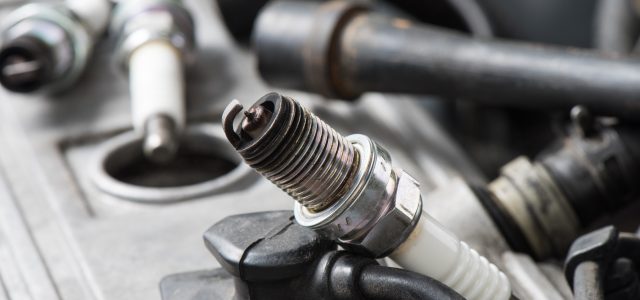

Spark Plug Replacement: Why, When and How
Car Repair July 12, 2018 0
Spark plugs are some of the more mystifying parts of the internal combustion. They are so small, yet so vital and are hard to keep track off. There are few ways to keep track of a spark plugs effectiveness and lifetime so it can be a real pain figuring out when and why to replace them.
Then there’s the issue of how. Getting under the hood is never an easy prospect for someone with little to no automotive care experience. However, the process is not so esoteric that you can’t do it at home on your own. By understanding the nature of spark plugs, their expected lifespan, the warning signs that signal new plugs are needed and how to replace them you can save yourself a lot of time and money on the spark plug replacement cost.
Spark Plugs: The Basics
So you want to know what a spark plug is. That’s OK. Despite most people knowing they exist, not as many people know what it does and how. Fewer still know the dangers or risks of a faulty or old one. Because of this lack of common knowledge, spark plug replacement can seem daunting, but some cursory information can dispel some of the uncertainty.
What They Do
The internal combustion engine relies on the flammable properties of gasoline to power whatever it is that the engine is attached to. In most cases, this is a car, but smaller engines power things like lawn mowers and larger ones can power things like boats. But for the gasoline to burn, combust, expand and drive a piston, it has to be ignited. That’s where spark plugs come in.
Spark plugs are connected to the area that fuel is injected into and, with electricity from the battery, creates a spark that sets the gasoline and air mixture alight. There are metal prongs in the spark plug that, when charged, create a spark between them that can reach up to 107,000 degrees Fahrenheit!
The number of spark plugs varies from engine to engine, but typically there is one spark plug per cylinder of the engine. So a V6 engine, for example, has six spark plugs. However, some engines have many more, up to double the number of cylinders.
What They Are Made Of
A spark plug is comprised of a shell, insulator and central conductor. They are mostly metal but usually incorporate a ceramic shell to insulate it. One end of the spark plug is threaded as it screws directly into the fuel chamber. The tip of the spark plug is right there in with the exploding fuel, so spark plugs are constructed out of tough materials. Miles of continuous operation, however, put a strain on the spark plug and eventually signs of wear will begin to show.
When to Replace Spark Plugs
Your owner’s manual, vehicle dealer or repairman can tell you how often your make and model should get its plugs replaced, but sometimes they burnout beforehand. Since a spark plug is so small and it is tucked away in the engine out of sight, it can be hard to gauge its status. Fortunately, or perhaps, unfortunately, your vehicle will begin to act up in a variety of ways when a spark plug is starting to go bad. There will be plenty of signs that its time for a change, you just need to know what to look for.
Your Vehicle Has Trouble Starting
If you find that your automobile takes a few tries to get going, or doesn’t start at all, it may be the spark plugs. Check the fuel and battery, and if these are both fine, it’s likely one or more spark plugs not sparking the fuel well enough. Check them early, too, as faulty spark plugs might drain the battery.
Jittery, Rough and Uneven Idle
When your vehicle is running, but you aren’t hitting the gas, it is idling, and it should be pretty smooth. The engine should be stable at around 1000 rpm and be purring like a kitten. If the engine jolts, jerks, shakes and makes a lot of noise while just sitting there, your spark plugs may be misfiring and in need of adjustment or replacement. Don’t wait, either; all that vibration can knock things loose and cost you a bundle in repairs if left alone.
Poor Acceleration
If you have had your vehicle long enough to wear out a spark plug, then you should know by now how it feels when you put your foot down. If your ride isn’t accelerating like it used to and is slow and unresponsive to the gas pedal, it could be the spark plugs. The misfires mean your engine is getting flooded with unignited gas. This, as you can imagine, is not great for the engine and you should address the problem immediately.
The Engine “Jumps”
You might notice that the engine in your vehicle surges in power then continuously slows down or stops and starts. This behavior is likely because the engine’s combustion process is sucking in too much air and the spark plugs are not firing in correct time. This can be bad if you are in traffic and can raise your risk of collision.
Poor Fuel Economy
If you notice that your vehicle is guzzling more gas than usual, it could be the spark plugs are old and faulty. They are failing to efficiently burn the fuel mixture and wasting a lot of it. This is not so dangerous to your engine or life, but it can be pretty hazardous to your bank account.
How to Replace Spark Plugs
Now that you have determined that your spark plugs need to be replaced, it’s time to get down to business. Make sure your vehicle is parked with the engine off. Also, let it cool down first if you just shut it down.
1. Get New Plugs
Before you go replacing anything you need something to replace it with. Check your owner’s manual for your vehicle or consult the literature and employees at an auto parts store which is where you are likely going to buy the plugs. There are hundreds of different spark plugs out there, and every vehicle has a different configuration so double check which ones you need.
2. Locate The Spark Plugs
Of course, you have to find the spark plugs before you can replace them. Refer to your owner’s manual to find out where they are. If you lost the manual, you can likely find a copy online. Spark plugs are usually affixed to the top of the engine.
3. Get the Right Tools
To remove a spark plug, you’ll need some special tools that you can get at any hardware store. You’ll need a ratchet socket drive wrench with an extension bar as well as spark plug socket; these are usually included in most ratchet socket sets. You will also need a gap gauge. This little tool is available at automotive stores and is used to check and adjust the gaps between the leads of spark plugs where the spark jumps.
4. Pull out the Leads
Each spark plug has a lead wire connected to it insulated with rubber or something similar. Pull gently and slowly on this lead until it comes all the way out. Don’t jerk it quickly or you could damage it and cause damage you likely aren’t prepared to fix. Also, don’t forget which lead goes into which spark plug if you do more than one at a time; consider marking them to keep track.
5. Unscrew the Spark Plug
Insert your socket wrench carefully into the hole that the lead came out of and affix it to the spark plug. Slowly turn your wrench counterclockwise until the plug comes free. Again, very slowly and carefully, pull the wrench with the plug in it out of the hole so as not to scratch the sides.
6. Clean the Threads
Check to see if the threads where the spark plug fits in are dirty. Also, check the wire terminals for gunk and use compressed air or a wire brush to clean them off.
7. Check the Gaps
With your gap gauge, measure the small distance between the leads of the spark plug on the “business end.” There are different types of gap gauges so read the instructions that came with yours or ask the salesperson you bought it from to learn how to do this. Again, check your manual to see what the gap distance should be. You can increase the distance with the gap gauge or other electrode bending tool. To shorten the distance just tap it lightly against a hard surface.
8. Install the New Spark Plug
To complete your spark plug replacement, affix the new and gap measured spark plug into your ratchet the insert them back into the spark plug socket. Tighten the spark plug to hand tight, then maybe another 1/8th turn. Never over tighten a spark plug as this can strip the threads and be catastrophic for your engine. If you can get it, apply a thin coat of dielectric grease (available at auto supply stores) in and around the insides of the spark plug boot. This can help prevent misfires. Then reinstall the lead wires so that it looks like it did before and that’s it!

No comments so far.
Be first to leave comment below.